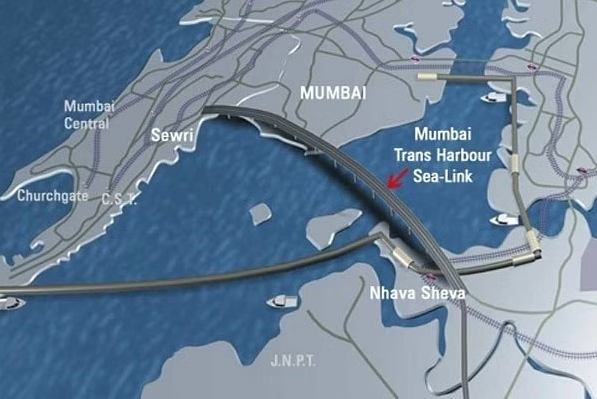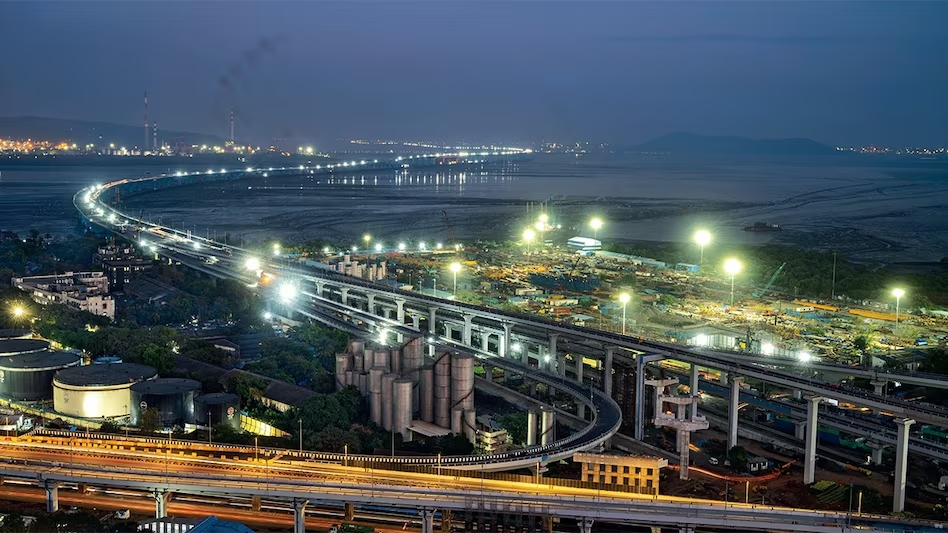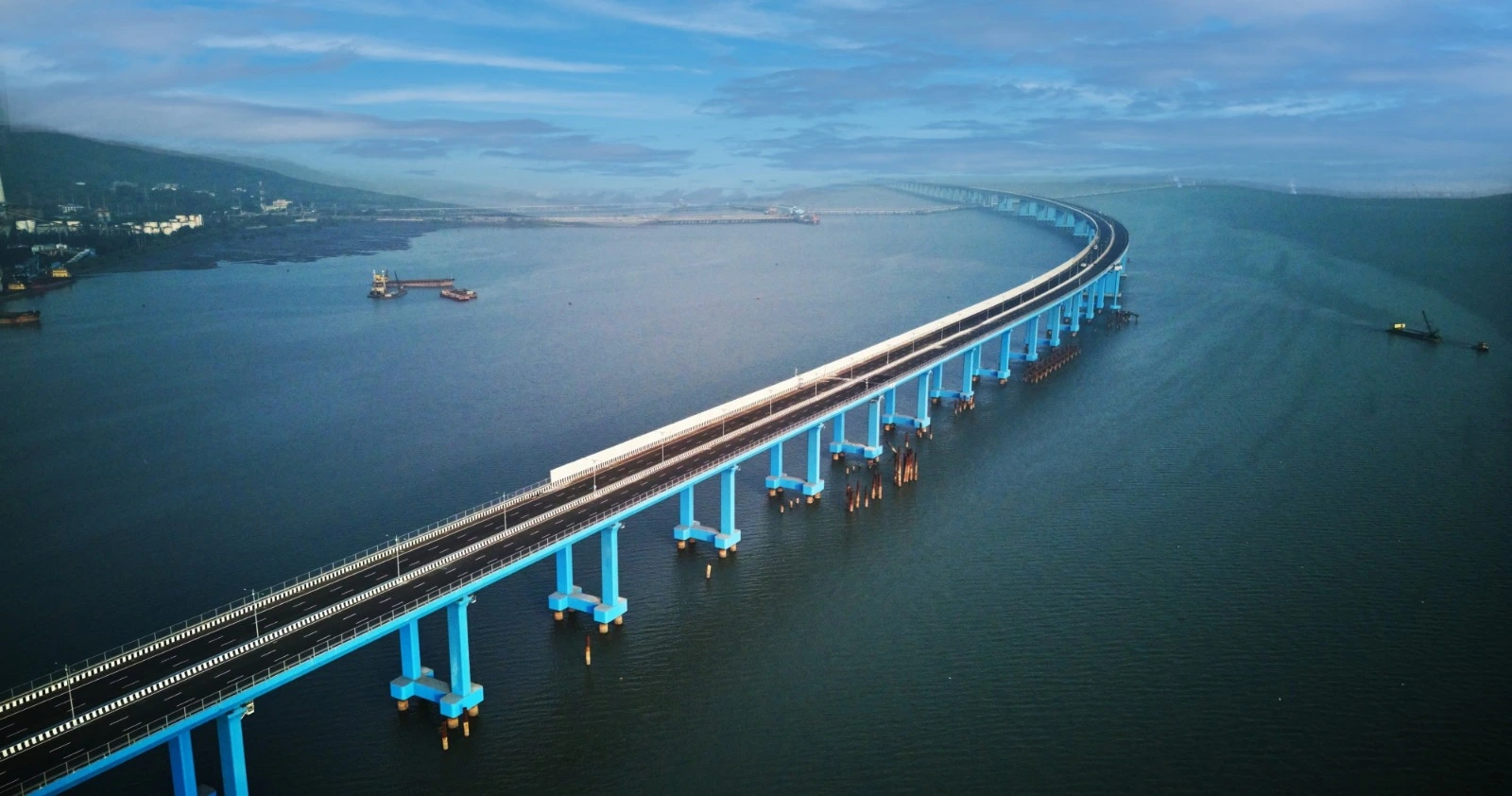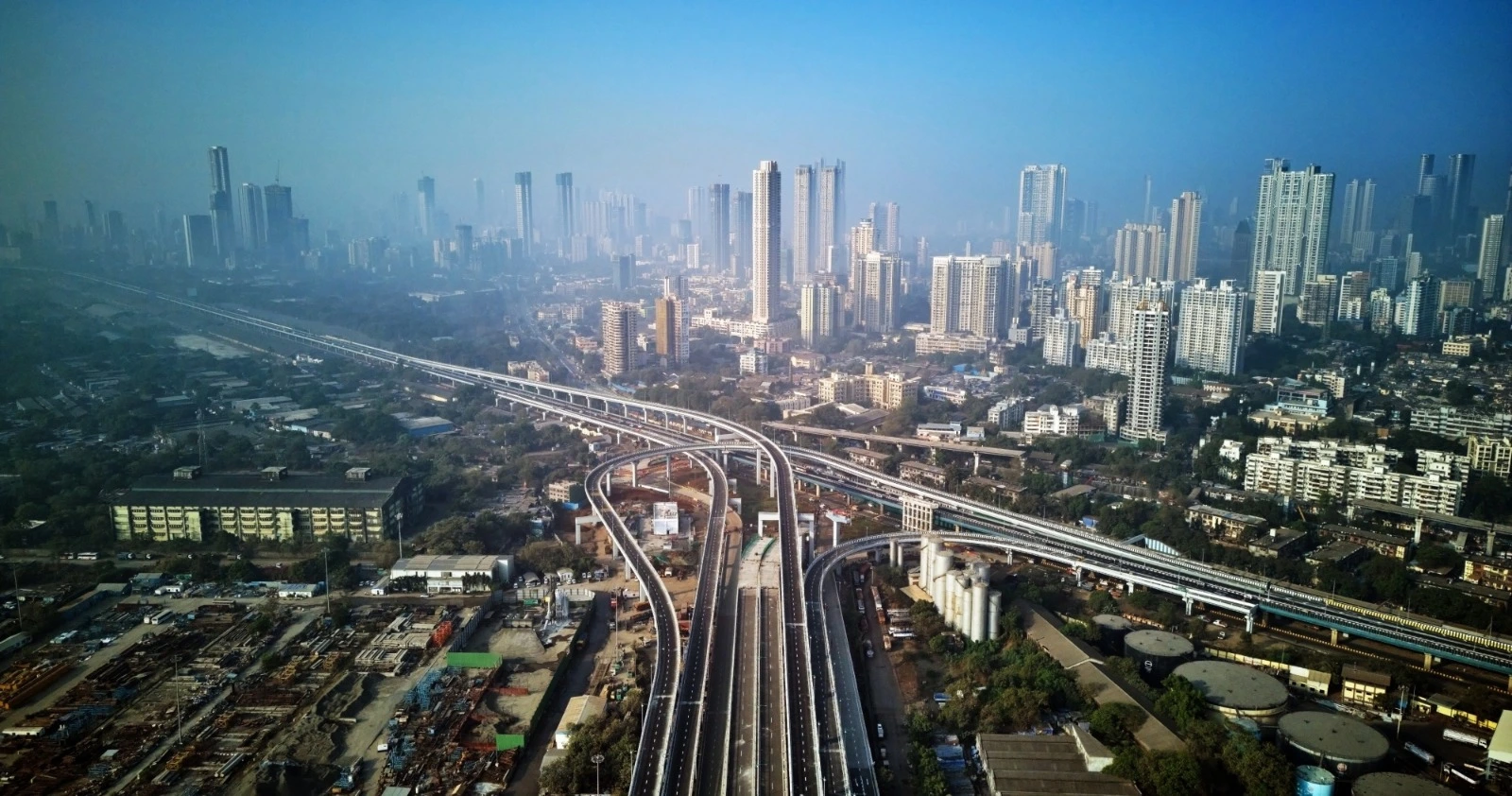Table of Contents
Project Highlights
- Name: The Atal Setu Nhava Sheva Sea Link
- Location: Connecting Mumbai and Navi Mumbai
- Significance: Game-changer for Mumbai residents, reducing travel time
- Length: Stands at 22 kilometers
- Features: Equipped with cutting-edge technology and designed to withstand earthquakes
- Inauguration: Inaugurated by Prime Minister Narendra Modi on 12th January 2024
- Impact: Expected to boost economic development and ease traffic congestion
The Mumbai Trans Harbour Link (MTHL), also called The Atal Setu Nhava Sheva Sea Link, is a 21.8 km long freeway-grade road bridge connecting Mumbai and Navi Mumbai. It was inaugurated by the Prime Minister on the 12th of January, 2024. Featuring 6 lanes, it is designed to accommodate approximately 70,000-80,000 vehicles annually.
Recognizing the impending saturation of the northern and northeastern parts of Greater Mumbai, planners sought expansion possibilities towards the mainland, especially north of Greater Mumbai up to Virar. The burgeoning pressure on rail and road networks necessitated a strategic shift towards an east-west orientation, directing development to the mainland on the coast, particularly the southern half of Navi Mumbai.
Location
The Atal Setu Nhava Sheva Sea Link, India's longest sea bridge, strategically spans the Arabian Sea, connecting Mumbai's island part with the mainland. This engineering marvel significantly reduces travel time between Sewri and Chirle, offering a vital link that enhances regional connectivity and promotes economic growth in the Mumbai metropolitan region.

Project Background
The Atal Setu Nhava Sheva Sea Link, covering 2,500 hectares, addresses Mumbai's transportation challenges, particularly congestion on the Airoli and Vashi bridges. Recognized in the 2008 Comprehensive Transportation Study, the Mumbai Metropolitan Region Development Authority emphasized its vital role in the city's survival and future growth.
As a transformative project, it links Mumbai and Navi Mumbai, aiming to ease congestion and enhance regional connectivity. Commencing construction in 2018, the 22-kilometer bridge, named after Atal Bihari Vajpayee, symbolizes engineering excellence.
Anticipated to reduce travel time significantly and stimulate economic activities, the Atal Setu Nhava Sheva Sea Link embodies India's commitment to advanced urban connectivity and sustainable development.
Project Objectives
The Atal Setu Nhava Sheva Sea Link, India's longest sea bridge, is a monumental infrastructure project aimed at achieving several key objectives to enhance the overall socio-economic landscape of the Mumbai metropolitan region. Spanning approximately 22 kilometers, this ambitious project serves as a critical component in the development plan for the region, and its goals are outlined as follows.
Find Bridge Construction Projects and Tenders in IndiaGet Started Now!
Enhance Regional Connectivity
One of the primary objectives of the Atal Setu Nhava Sheva Sea Link (MTHL) is to significantly improve regional connectivity between Mumbai and Navi Mumbai. The pre-existing transportation infrastructure often faces challenges related to congestion and limited capacity, leading to inefficiencies in the movement of people and goods. The sea link, by connecting these two major urban centers, creates a vital corridor that not only reduces travel time but also facilitates smoother and more efficient movement of traffic. This improved connectivity is crucial for fostering better integration and collaboration between the two regions, promoting a more cohesive and interconnected metropolitan area.
Alleviate Traffic Congestion
The project addresses the pressing issue of traffic congestion, a common problem in rapidly growing urban areas. Mumbai, being one of the most populous cities in the world, experiences severe traffic jams that adversely impact productivity and quality of life. The Atal Setu Nhava Sheva Sea Link aims to alleviate this congestion by providing an alternative route, diverting a significant portion of traffic away from the existing road networks. The enhanced connectivity and reduced travel times contribute to a more streamlined transportation system, benefiting both commuters and businesses equally.
Stimulate Economic Development
By improving connectivity and reducing transportation bottlenecks, the sea link becomes a catalyst for economic development in the Mumbai metropolitan region. Efficient transportation infrastructure is a key driver of economic growth, enabling businesses to operate more effectively and facilitating the movement of goods and services. The Atal Setu Nhava Sheva Sea Link, with its potential to ease logistical challenges and enhance accessibility, is expected to attract investment, promote commerce, and contribute to the overall economic vibrancy of the region. The project aligns with broader developmental goals, supporting the creation of a conducive environment for businesses to thrive and encouraging sustainable economic growth.
As a critical piece of transportation infrastructure, it holds the promise of reshaping the urban landscape and fostering a more dynamic and interconnected economic hub.
Technical Specifications
The technical specifications of MTHL underscore its commitment to excellence, leveraging innovative technology and engineering prowess to create a resilient and enduring infrastructure that addresses the complex challenges of Mumbai's transportation landscape.
Length
Mumbai Trans Harbour Link (MTHL) spans an impressive 22 kilometers, making it a monumental engineering feat and the longest sea bridge in India.
Technology
The project incorporates advanced engineering and design features, showcasing state-of-the-art technological solutions to meet the demands of modern infrastructure.
No Toll Queues with Open Road Tolling (ORT) System
- Eliminates boom barriers, inspired by Singapore's successful ORT system.
- Advanced scanners and cameras identify moving vehicles for seamless toll collection.
- Enhances commuter experience, fuel efficiency, safety, and cost-effectiveness.
See-Through Crash Barrier for Uninterrupted Sea Views
- A barrier at 1.55 meters in height to avoid blocking sea views from car seats.
- Comprises a concrete section (90cm) and a metal rail, creating a visually unobtrusive design.
- Originally planned solid wall shelved for a more aesthetic experience.
Dynamic Displays for Real-Time Information
- Provides motorists with real-time information on traffic congestion, accidents, and emergencies.
Special Recyclable Road Surface for a Smooth Ride
- Paved with stone matrix asphalt for enhanced durability and performance.
- Offers 20-30% increase in pavement life, resistance to temperature variations, reduced traffic noise, and improved skid resistance.
- 100% recyclable at the end of its service life.
Surveillance and Detection Systems for Enhanced Safety
- A network of high-definition cameras monitors traffic and facilitates emergency response.
- Video incident detection system identifies stalled vehicles, unauthorized pedestrian movement, wrong-side driving, fires, and obstacles.
- Speed violation detection system penalizes motorists exceeding the 100kmph speed limit.
Special Light Poles for Environmental Considerations
- Addressing environmental concerns, 1,212 special light poles only illuminate the carriageway.
- This makes sure that no light gets spilled into the sea and ensures minimal disturbance to marine life at night.
Resilience
MTHL is constructed with resilience in mind, and designed to withstand seismic activities. This crucial feature enhances the bridge's ability to endure and remain functional even in the event of seismic events, reinforcing its role as a robust and reliable transportation link.
Significance
Addresses the growing need for efficient transportation in the Mumbai Metropolitan Region
The Mumbai Trans Harbour Link (MTHL) significantly addresses the escalating demand for efficient transportation in the Mumbai Metropolitan Region (MMR). By creating a seamless connection between Mumbai and the mainland, particularly the southern half of Navi Mumbai, MTHL alleviates congestion on existing routes. The link's open road tolling system minimizes delays, ensuring a smooth flow of traffic. Moreover, dynamic displays, surveillance systems, and a pothole-resistant, recyclable road surface enhance safety and commuter experience. As a vital infrastructure project, MTHL not only caters to the immediate transportation needs but also lays the foundation for sustainable growth and development in the region.
Promotes economic growth by facilitating smoother movement of goods and people
The Atal Setu Nhava Sheva Sea Link serves as a linchpin for economic growth by streamlining the movement of goods and people. Connecting Mumbai to the mainland, MTHL significantly reduces travel time, alleviates congestion, and enhances overall transportation efficiency. This seamless connectivity facilitates the swift movement of goods, promoting a more agile supply chain and reducing logistics costs. Simultaneously, commuters experience improved accessibility, fostering greater workforce mobility and economic activity. By addressing transportation bottlenecks, MTHL becomes a catalyst for economic growth, attracting investment, stimulating commerce, and laying the foundation for a more robust and interconnected regional economy.
Find Bridge Construction
Projects and Tenders in India Get Started Now!
Impact on Connectivity
Reduces travel time between Mumbai and Navi Mumbai
The Mumbai Trans Harbour Link (MTHL) significantly reduces travel time between Mumbai and Navi Mumbai by providing a direct and efficient link across the harbor. Spanning 22 kilometers, MTHL offers a quicker alternative to existing road links like the Airoli and Vashi bridges. With its modern infrastructure, the bridge facilitates seamless connectivity, minimizing commute durations and enhancing overall transportation efficiency between the two major urban centers, ultimately benefiting commuters and promoting economic activities in the region.
Enhances overall accessibility for residents and businesses
The Mumbai Trans Harbour Link enhances overall accessibility for residents and businesses by providing a vital east-west corridor, reducing travel time between Mumbai and Navi Mumbai. With features like open road tolling, see-through crash barriers for uninterrupted sea views, dynamic displays for real-time information, a smooth and durable stone matrix asphalt surface, and advanced surveillance systems, the link ensures efficient and seamless transportation. This transformative infrastructure facilitates smoother movement, easing commuting challenges, and fostering economic growth in the region.
Traffic Management
The following features collectively enhance Mumbai's traffic management, promoting a safer, more efficient, and streamlined transportation system.
Open Road Tolling (ORT) System
Eliminates toll queues with advanced scanners and cameras for seamless toll collection.
Dynamic Displays
Provides real-time traffic information, including congestion alerts and emergency notifications.
Stone Matrix Asphalt Surface
Ensures a pothole-free ride, regardless of weather conditions, enhancing traffic flow.
Surveillance and Detection Systems
- A network of high-definition cameras monitors traffic, assisting emergency response.
- Video incident detection system identifies stalled vehicles, unauthorized movement, and obstacles.
- Speed violation detection system enforces the 100kmph speed limit.
Efficient Lighting
Special light poles illuminate only the carriageway, minimizing luminous spill onto the sea.
Future Prospects
The Atal Setu Nhava Sheva Sea Link promises to be a catalyst for sustained urban development, offering a seamless transportation network. Its advanced features and enhanced connectivity position it to play a pivotal role in fostering economic growth, tourism, and regional integration for years to come.
Sets the stage for future infrastructure development in the area
The Mumbai Trans Harbour Link (MTHL) lays a foundational framework for future infrastructure development in the region. By addressing critical transportation challenges and enhancing connectivity, MTHL facilitates streamlined movement between Mumbai and Navi Mumbai. This not only alleviates current congestion but also paves the way for sustained urban expansion, economic growth, and improved quality of life. MTHL's success sets a precedent for future projects, fostering a conducive environment for comprehensive and sustainable infrastructure development in the area.
Positions Mumbai as a hub for economic and logistical activities
The Atal Setu Nhava Sheva Sea Link positions Mumbai as a central hub for economic and logistical activities by significantly improving connectivity. Linking the island city with the mainland, MTHL reduces commuting times, facilitating smoother movement of goods and services. With advanced features like open road tolling, see-through crash barriers, and a recyclable road surface, MTHL enhances overall transportation efficiency, making Mumbai an attractive and viable center for economic growth and logistical operations.
Financial Details
Total Cost of the Project
The MTHL project incurred a total cost of approximately USD 2.2 billion, equivalent to around INR 17,843 crores.
Funding Sources and Amount
The funding for the MTHL project was a collaborative effort involving multiple entities. The Japan International Cooperation Agency (JICA) played a crucial role by providing financial assistance of around INR 8,600 crores (approximately USD 1.1 billion). Additionally, the Maharashtra state government contributed a significant share to the project's funding.
Project Delivery Mode
The project delivery method adopted for the MTHL project was a combination of public and private investment. While a substantial portion of the funding came from JICA and the state government, the project also incorporated a public-private partnership (PPP) mode. This mixed financing strategy allowed for a more diversified funding base, leveraging both government resources and private sector expertise to ensure the successful implementation of this major infrastructure undertaking.
Stakeholders involved
Government of India & Local authorities in Mumbai and Navi Mumbai
In synergy, the Government of India and local authorities in Mumbai and Navi Mumbai navigate the complexities of policy, finance, regulation, and public engagement to realize the transformative vision of the MTHL, enhancing regional connectivity and stimulating economic growth.

Design, Engineering, and Construction firms involved in the project
The following companies collectively formed a formidable consortium, leveraging their diverse skill sets to successfully design, engineer, and construct the Mumbai Trans Harbour Link. Their collaboration reflects the international nature of the project and ensures that MTHL benefits from a blend of global best practices and local expertise.
| Package | Companies involved | Aspects Covered | Cost |
|---|---|---|---|
| 1 | Larsen and Toubro and IHI Corporation | Construction of 10.38 Km Long Bridge portion across Thane Creek, and the Sewri Y-interchange | INR 7637 Cr approx |
| 2 | Tata Projects Limited and Daewoo E&C | Construction of 7.807 km long Bridge portion across Thane Creek, and the Shivaji Nagar cloverleaf interchange | INR 5612 Cr approx |
| 3 | Larsen and Toubro | Construction of 3.613km long via duct section and interchanges that connect MTHL with State Highways 52 and 54 and National Highway 4B at Chirle | INR 1013 Cr approx |
| 4 | Strabag Infrastructure | Intelligent transport system, toll management, street lighting, electrical works, toll plazas, and administrative buildings | INR 427 Cr approx |
Larsen & Toubro (L&T)
A key player in India's engineering and construction sector, L&T played a crucial role in executing The Atal Setu Nhava Sheva Sea Link project.
Contributed extensive expertise in infrastructure development and project management.
Tata Projects
Renowned for its contributions to major infrastructure projects, Tata Projects collaborated on the MTHL venture, bringing in diverse engineering capabilities and experience.
IHI Corporation (Japan)
Japan's IHI Corporation, a globally recognized engineering and construction firm, partnered in the project, contributing cutting-edge technology and international best practices.
Daewoo Engineering
The South Korean firm, Daewoo Engineering, added its significant engineering prowess to the MTHL project, leveraging its experience in executing large-scale infrastructure ventures.
Strabag Infrastructure (Austria)
Strabag, an Austrian construction company, played a role in shaping MTHL's development, bringing European engineering standards and innovation to the project.
Environmental Considerations
The Atal Setu Nhava Sheva Sea Link prioritizes environmental sustainability and commits to obeying the related regulations. Also, with its intention to create a positive environmental impact wherever possible, it emerges as an infrastructure development that brings on the plate multifaceted advantages.
Sustainable Lighting
1,212 special light poles designed to illuminate only the carriageway
to minimize luminous spill onto the sea, addressing concerns about disturbing marine life
Find Bridge Construction
Projects and Tenders in India Get Started Now!
Wrapping Up
The Atal Setu Nhava Sheva Sea Link, inaugurated by Prime Minister Narendra Modi on 12th January 2024, stands as a monumental achievement in urban infrastructure development. With a length of 22 kilometers, it not only significantly reduces travel time between Mumbai and Navi Mumbai but also emerges as a game-changer for residents, offering enhanced connectivity and economic opportunities.
The project's use of cutting-edge technology, sustainable practices, and collaboration with international entities showcase India's commitment to modernizing transportation infrastructure. As it transforms Mumbai's urban landscape, the Atal Setu Nhava Sheva Sea Link sets the stage for sustained economic growth and future infrastructure development in the region.
It represents a significant investment in infrastructure, poised to transform regional connectivity, reduce congestion, and drive economic development in the Mumbai Metropolitan Region.
Discover more such projects with ease
Are you looking for a platform that gives you reliable, high-quality, and timely project insights for the Latest Bridge (Viaduct) Construction Projects in the India Region?
Discover the Global Project Tracking (GPT) platform by Blackridge Research, designed to provide you with the most recent Bridge (Viaduct) Construction Projects in the Indian Region better and faster across various stages of development:
- Upcoming projects
- Tender Notices
- Contract award announcements
- Projects in progress or under construction
- Successfully completed projects.
The user-friendly interface helps you obtain early-stage awareness of projects and find the right business opportunity quickly.
Each project will have all the essential details, such as scope, capacity, CapEx, status, project description, companies involved, funding information, location, periodic updates, important event dates like construction start date, commissioning dates, and key contact information of project owners and stakeholders.
The database is a vital resource for a wide range of entities, including developers, EPC Companies, project owners, Operation and Maintenance (O&M) companies, data analytics and software providers, consulting and advisory firms, investors, infrastructure investment firms, project finance agencies, research and development organizations, regulatory bodies, and law firms.
Book a Free demo to learn more about the Bridge (Viaduct) Construction Projects in the Indian Region database and how we can help you achieve your goals









Leave a Comment
We love hearing from our readers and value your feedback. If you have any questions or comments about our content, feel free to leave a comment below.
We read every comment and do our best to respond to them all.